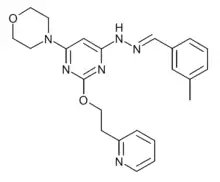Apilimod
Apilimod (STA-5326) is a drug that was initially identified as an inhibitor of production of the interleukins IL-12 and IL-23, and developed for the oral treatment of autoimmune conditions such as Crohn's disease and rheumatoid arthritis,[1] though clinical trial results were disappointing and development for these applications was not continued.[2][3]
 | |
| Clinical data | |
|---|---|
| Trade names | Apilimod |
| Legal status | |
| Legal status | |
| Identifiers | |
| |
| CAS Number | |
| PubChem CID | |
| DrugBank | |
| ChemSpider | |
| UNII | |
| ECHA InfoCard | 100.237.985 |
| Chemical and physical data | |
| Formula | C23H26N6O2 |
| Molar mass | 418.5 g·mol−1 |
| 3D model (JSmol) | |
| |
| |
Subsequently, it was discovered that apilimod has an additional mode of action, as an inhibitor of the lipid kinase enzyme PIKfyve.[4][5] PIKfyve makes two lipids, PtdIns5P and PtdIns(3,5)P2, whose syntheses are efficiently and similarly inhibited by apilimod (ID50 = 0.4 nM) in in vitro assays. Administration of apilimod (100 nM; 60 min) in human embryonic kidney cells powerfully reduces levels of both PtdIns5P and PtdIns(3,5)P2.[6]
Recently apilimod has been repurposed as a potential antiviral and anti-cancer drug, with possible applications in the treatment of non-Hodgkin lymphoma as well as viral diseases such as Ebola virus disease, Lassa fever and COVID-19.[7][8][9][10][11]
References
- Billich A (January 2007). "Drug evaluation: apilimod, an oral IL-12/IL-23 inhibitor for the treatment of autoimmune diseases and common variable immunodeficiency". IDrugs. 10 (1): 53–9. PMID 17187316.
- Sands BE, Jacobson EW, Sylwestrowicz T, Younes Z, Dryden G, Fedorak R, Greenbloom S (July 2010). "Randomized, double-blind, placebo-controlled trial of the oral interleukin-12/23 inhibitor apilimod mesylate for treatment of active Crohn's disease". Inflammatory Bowel Diseases. 16 (7): 1209–18. doi:10.1002/ibd.21159. PMID 19918967. S2CID 26012456.
- Krausz S, Boumans MJ, Gerlag DM, Lufkin J, van Kuijk AW, Bakker A, et al. (June 2012). "Brief report: a phase IIa, randomized, double-blind, placebo-controlled trial of apilimod mesylate, an interleukin-12/interleukin-23 inhibitor, in patients with rheumatoid arthritis". Arthritis and Rheumatism. 64 (6): 1750–5. doi:10.1002/art.34339. PMID 22170479.
- Shisheva A, Sbrissa D, Ikonomov O (1999). "Cloning, characterization, and expression of a novel Zn2+-binding FYVE finger-containing phosphoinositide kinase in insulin-sensitive cells". Molecular and Cellular Biology. 19 (1): 623–634. doi:10.1128/mcb.19.1.623. PMC 83920. PMID 9858586.
- Cai X, Xu Y, Cheung AK, Tomlinson RC, Alcázar-Román A, Murphy L, et al. (July 2013). "PIKfyve, a class III PI kinase, is the target of the small molecular IL-12/IL-23 inhibitor apilimod and a player in Toll-like receptor signaling". Chemistry & Biology. 20 (7): 912–21. doi:10.1016/j.chembiol.2013.05.010. PMC 4878021. PMID 23890009.
- Sbrissa D, Naisan G, Ikonomov OC, Shisheva A (September 2018). "Apilimod, a candidate anticancer therapeutic, arrests not only PtdIns(3,5)P2 but also PtdIns5P synthesis by PIKfyve and induces bafilomycin A1-reversible aberrant endomembrane dilation". PLOS ONE. 13 (9): e0204532. doi:10.1371/journal.pone.0204532. PMC 6150535. PMID 30240452.
- Gayle S, Landrette S, Beeharry N, Conrad C, Hernandez M, Beckett P, et al. (March 2017). "Identification of apilimod as a first-in-class PIKfyve kinase inhibitor for treatment of B-cell non-Hodgkin lymphoma". Blood. 129 (13): 1768–1778. doi:10.1182/blood-2016-09-736892. PMC 5766845. PMID 28104689.
- Nelson EA, Dyall J, Hoenen T, Barnes AB, Zhou H, Liang JY, et al. (April 2017). "The phosphatidylinositol-3-phosphate 5-kinase inhibitor apilimod blocks filoviral entry and infection". PLOS Neglected Tropical Diseases. 11 (4): e0005540. doi:10.1371/journal.pntd.0005540. PMC 5402990. PMID 28403145.
- Hulseberg CE, Fénéant L, Szymańska-de Wijs KM, Kessler NP, Nelson EA, Shoemaker CJ, et al. (April 2019). "Arbidol and Other Low-Molecular-Weight Drugs That Inhibit Lassa and Ebola Viruses". Journal of Virology. 93 (8). doi:10.1128/JVI.02185-18. PMC 6450122. PMID 30700611.
- Ikonomov OC, Sbrissa D, Shisheva A (November 2019). "Small molecule PIKfyve inhibitors as cancer therapeutics: Translational promises and limitations". Toxicology and Applied Pharmacology. 383: 114771. doi:10.1016/j.taap.2019.114771. PMID 31628917.
- "Researchers use live virus to identify 30 existing drugs that could treat COVID-19 | SBP". www.sbpdiscovery.org. Retrieved 2020-04-20.